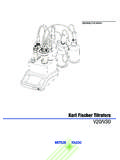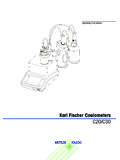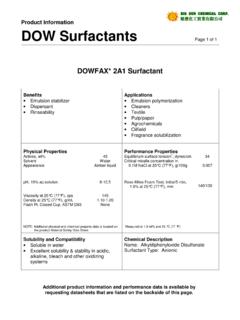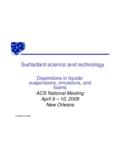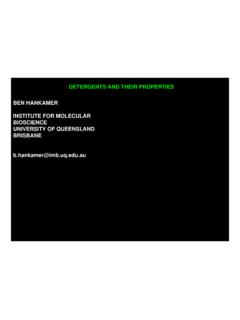Transcription of 51725015 Surfac 22e - bikeitech.com
1 Titration Applications Brochure 22 Surfactant Titrationfor METTLER TOLEDOT itrators DL50/DL53/DL55/DL58 OSO3- Na+Hydrophobic groupHydrophilic group WaterMicellePage 2/68 DL50 DL53 DL55 DL58 METTLER TOLEDO Titrators Surfactant TitrationEditorialDear ReaderSurfactants and detergents are an integral part of our daily life. Be it cleaning, dishwashing or personalhygiene, we all have a great deal of contact with these substances. Analysis of surfactant concentrationis an important quality criterion in is with pleasure that we present to you this unique and comprehensive application brochure, whichprovides essential information on different analytical techniques used for surfactant thanks go to Cosimo De Caro, an experienced applications chemist, who put in tremendous effortsin the development of this wish you a lot of success in surfactant titration !
2 Christian WalterRolf M. RohnerManager Market Support AnaChemMarketing Manager TitrationSurfactant TitrationDL50 DL53 DL55 DL58 METTLER TOLEDO Titrators Page 3/68 ContentsIntroduction .. 4 Turbidimetric titrations .. 9M603 Turbidimetric titration: Determination of anionic surfactants .. 10M604 Turbidimetric titration of a cocoamidopropylbetaine solution .. 14M605 Turbidimetric titration of nonionic surfactants .. 16 Colorimetric Two-Phase Titrations .. 20M606 Standardization of Hyamine by Two-Phase Titration (DL58) .. 22M607 Determination of anionic surfactants by Two-Phase Titration (DL58) .. 24M073 Two-Phase Titration with DL77: Standardization of Hyamine 1622 .. 28M074 Two-Phase Titration with DL77: Anionic surfactants determination.
3 31M608 Mixed Two-Phase Titration: Standardization of Hyamine 1622 .. 35M609 Mixed Two-Phase Titration: Anionic surfactants in liquid detergents .. 37 Potentiometric titrations .. 40M610 Titer of Hyamine mol/L by potentiometric titration .. 41M611 Titer of SDS mol/L by potentiometric titration .. 43M612 Titer of sodium tetraphenylborate by potentiometric titration .. 45M613 Potentiometric titration of anionic surfactants in liquid detergents .. 47M614 Potentiometric titration of nonionic surfactants in raw materials .. 50M615 Potentiometric titration of a betaine in shampoo .. 54M081 Anionic components in water soluble metal working fluids .. 56 Surfactant titration: Comparison of different techniques.
4 60 Conclusions .. 63 Checklist for surfactant titration .. 64 Literature .. 67 Page 4/68 DL50 DL53 DL55 DL58 METTLER TOLEDO Titrators Surfactant TitrationIntroductionSurfactants is the generic name for substances with a surface active behaviour. They have a characteristicstructure with one or more hydrophobic (no affinity to water) and one or more hydrophilic groups(strong affinity to water) [see literature ref. 1-5]Fig. 1:Hydrophobic groupHydrophilic groupIn aqueous solutions, the hydrophilic groups of the surfactant molecules are in contact with water,whereas the hydrophobic groups attempt to avoid water by emerging from the solution. Thereby theyform a monomolecular layer that covers the surface of the solution (see fig.)
5 2).Surface tension results from interaction of neighbouring molecules forming the layer. Since theinteraction between a surfactant and a water molecule is weaker than that between two water molecules,the surface tension of a surfactant solution is considerably reduced compared to a specific concentration is reached and the surface of a solution is completely covered, additio-nal surfactant molecules form spheric aggregates: micelles. This concentration is called the criticalmicelle concentration (cmc). In a micelle, the hydrophilic groups build the surface of the sphere andthe hydrophobic tails are oriented towards the center of the micelle. The hydrophobic center allowsthe inclusion of nonpolar molecules (Fig.
6 2). WaterMicelleSodium palmitinate:C15H31 COONaSodium stearate:C17H35 COONaSodium laurinate:C11H23 COOHCOO- Na+For this reason, surfactants increase the dissolving power of water for organic nonpolar substances( fat) and are therefore used as detergents in many applications. Soaps, the sodium (Na+) orpotassium (K+) salts of fatty acids, are well-known examples of surfactants:Fig. 2:Surfactant TitrationDL50 DL53 DL55 DL58 METTLER TOLEDO Titrators Page 5/681. Anionic Surfactants (negative charge)Alkyl sulphate Sodium lauryl sulphate (Sodium dodecyl sulphate, SDS)Linear alkylbenzene sulphonate (LAS)Alkylbenzene sulphonate (ABS)Alkyl ether sulphate CH3(CH2)10CH2O(CH2CH2O)4SO3- Na+ Sodium n-dodecyltetraethoxysulphate (Sodium laureth sulphate)2.
7 Cationic Surfactants (positive charge)Alkyl pyridinium salts n-Cetylpyridinium chloride (CPC, M = 340 g/mol) usually available as CPC monohydrate, M = g/molQuaternary ammonium salts Benzethonium chloride (Hyamine 1622, M = g/mol)Imidazolium salts DDMICl (1,3-didecyl-2-methyl-imidazolium chloride, M = g/mol)Fatty quaternary ammonium saltsC16H33 N+Types of surfactantsSurfactants are classified according to the type and charge of the hydrophilic groups present in themolecule. We distinguish four different classes: anionic-, cationic-, nonionic- and amphoteric these surfactants, anionic surfactants (including soap) are the most important, with a worldwidemarket share of 55% (1991), followed by the nonionic (39%), cationic (4%) and amphoteric detergents(2%).
8 The advantage of nonionic surfactants is their high solubility at low temperature, which is idealfor laundry temperatures of about 30 C. Among nonionic surfactants, sugar-based alkylpolyglucosides(APG) have to be mentioned since they are becoming more relevant these +Cl-OSO3- Na+SO3- Na+SO3- Na+Cl-Page 6/68 DL50 DL53 DL55 DL58 METTLER TOLEDO Titrators Surfactant Titration3. Nonionic Surfactants (no electric charge)Ethoxylated alkylphenolsCH3 CH CH2CH CH2 CH O(CH2CH2O)9H CH3 CH3 CH3 Nonylphenol 9-mole ethoxylateAlkyl polyethyleneglycolsCH3(CH2)10CH2O(CH2CH2 O)9 HDodecanol 9-mole ethoxylate ( 1 EO unit: -CH2CH2O- )4.
9 Amphoteric Surfactants CH3 AlkylbetainesC12H25 N+ CH2 COO- CH3 Dimethyl-dodecyl-betaine (Carboxybetaine)AmidobetainesCXH2X+1 CO NH (CH2)2 N+ CH2 COO-Alkyl ammonium sulphonatesCH3N-Decyl-N,N-dimethyl-3-amm onium-1-propane sulphonateUsually, surfactant molecules have not a single specific alkyl chain ( , C12 ), but they are characterizedby a distribution of alkyl chains of various lengths. For instance, betaines contained in commercialproducts such as shower foams and shampoos contain alkyl chains which can vary between C8 andC18 [4].In ethoxylated alkylphenols the number of EO-units ( , -CH2-CH2-O- ) can also vary between 7and 9. Thus, the indicated molecular mass M of a surfactant has usually to be understood as a weightedaverage value of the molecular masses of the components with various alkyl +SO3-CH3CH3 Surfactant TitrationDL50 DL53 DL55 DL58 METTLER TOLEDO Titrators Page 7/68 Surfactants in finished products and formulationsThe typical composition of formulated products, of which the analyses are documented in this brochure,is given below.
10 Cationic surfactants are used seldomly and were not amongst the analysed foam3(3)3 Water > 40-50%Additional components 1)Liquid detergents3(3)3 Water > 40-50%Additional components 2)Liquid dishwasher33 Water > 40-50%Additional components 3)Washing powder33 WaterFatty acidsAdditional components 4)Toothpaste (Gel)3 Water < 20%Additional components 5)1)small percentages:perfumes, dyes, stabilizers, cellulose derivatives and salt (viscosity), )small percentages:perfumes, dyes, stabilizers, salt (viscosity), )small percentages:perfumes, dyes, skin protective )small percentages:perfumes, enzymes, builders, borates, silicates, phosphates, )small percentages:amine fluorides, polyglucosides, silica, titanium dioxide, phosphates, cellulose, table has to be considered as an indicative table.
